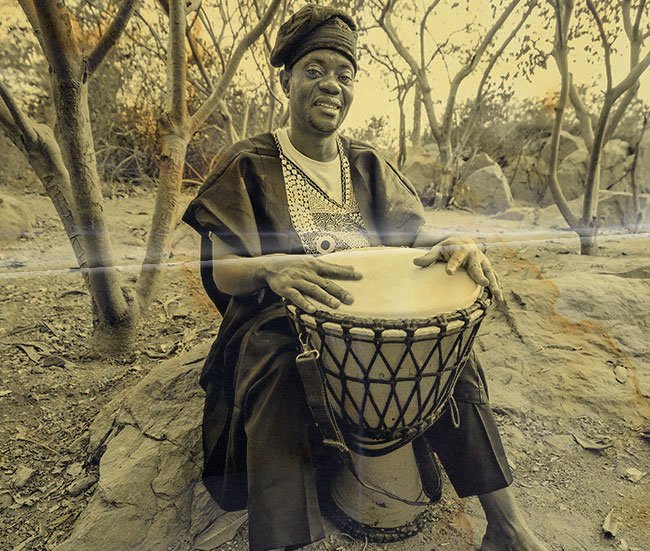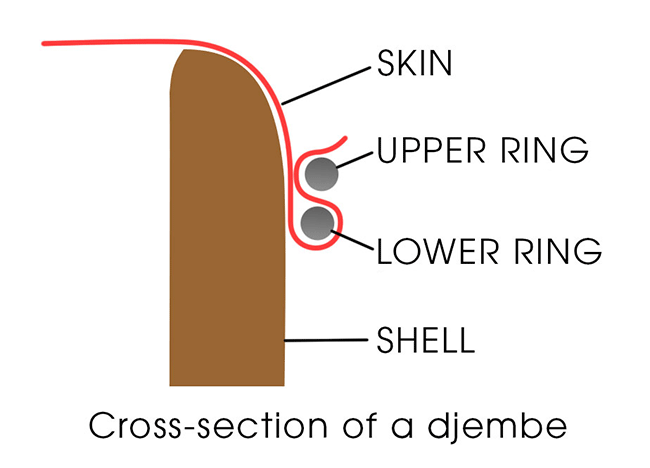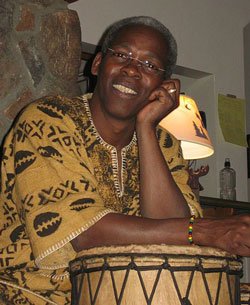1. What is a djembe?
Tell me like I'm an alien
The djembe ('jem-beh') is a musical instrument from West Africa.
It is part of a group of instruments called membranophones, or drums.
It is made of a hollow wood body, with skin fastened over the top.
The skin is traditionally rawhide, such as goat or cow skin. Modern djembes often use synthetic skins. The skin is tightly stretched over the shell using metal rings and rope.
The tightly stretched skin creates a sound when it is struck.
You play it by hitting it with your hands and fingers.

The drum is usually played in groups, consisting of other djembes, bass drums (called dunun, dun dun or djun djun) and percussion such as shakers and bells. It is often accompanied by dancing.
An average djembe is around 55-65cm in height (22-25 inches), with a diameter of 30-36cm (12-14 inches). They weight between 9-12 kgs (20-26 lbs).

2. What does the djembe drum sound like?
Here's an audio sample:
0:00 - 0:07 - Single drum 1
0:07 - 0:18 - Single drum 2
0:18 - 0:28 - Djembe ensemble with percussion and bass drums.
On the djembe there are three basic notes - the bass, tone and slap. The bass is the lowest pitch, the tone is in the middle register and the slap is the highest pitch.
The djembe is easily recognisable and is one of the loudest African drums. The tighter the skin, the louder the drum.
3. How is the sound produced?
Membranophones create sound from the vibration of a membrane, or skin.
When the drum is struck the skin reverberates and the shape of the hollow drum acts as amplifier. The sound is projected out of the bottom of the shell.
The notes are achieved by striking the drum in different places and with different parts of the hand.
There are many other types of African drums, most of which use the principle of a vibrating membrane.

4. Djembe pronunciation
Here's how to say the word djembe:
djembe (/’ʒɛmbə/)
The 'd' is silent.
It is pronounced 'jem-beh'.
Jem - as in 'gemstone'
Beh - like the beginning of 'bed'
The first syllable is emphasized (as with many African languages) - 'jem-beh'.
For the full article on this, check out djembe pronunciation and etymology (where the word comes from).
5. Djembe History
The drum of a thousand voices
The djembe has its origins with the Maninke people of West Africa around the 1300 AD.
The drum has a rich and colorful history, a tapestry of oral tradition recounted by generations of musicians and story tellers. For more, see the full article on djembe history.
Traditionally, the drum is more than just an instrument of entertainment. Songs and rhythms played on the drum are representative of events in the community, past and present, and a record for future generations.

In African culture, music is a story.
It's this story and mystique that makes it so appealing to a wide audience. Over the last 50 years, the drum has exploded in popularity across the globe and it's impact has been felt beyond just the world music scene.
6. A Traditional Djembe Ensemble
A typical ensemble contains one soloist, one or two accompanying djembe and from one to three dundun players. It is often accompanied by dancers and hand clapping.
The bass drums, or dundun, are usually played with sticks and provide the core structure of the rhythm. There are 3 types of bass drum that range in size and pitch. They are the doundounba, the sangban and the kenkeni.
The djembe accompanists each play different rhythms alongside the bass drum to complete the basic song. The soloist introduces the song, accents the beats, controls the tempo and plays solo pieces over the rhythm provided.
7. The Sekeseke
Two or three metal plates, called sekeseke (segesege in Mali, or kesekese in Guinea) can be attached to the edge of the djembe to create extra sound.

The edges of these plates have been pierced and threaded with many wire rings. They resonate in sympathy when the drum is played and accent the notes of the drum or kora (harp) with a jingling sound that adds to the 'voice of the drum'.
Similar resonators are used on other African instruments such as the mbira and the balafon.
8. Types of Djembe
There are broadly speaking two types of djembe - traditional, hand made drums and mass produced drums. For more, see our guide on how to buy a djembe.
TRADITIONAL HAND MADE DJEMBES

These are the most common type and have been made in Africa for centuries. The shell is a single piece of solid hardwood that has been carved out. The shell is chiselled and sanded to a smooth finish. Skin is then attached to the head of the drum using rope and metal rings. It is then tightened by hand to a playable pitch.
CONTEMPORARY MACHINE MADE DJEMBES

When djembes became widely popular in the 1990s, instrument manufacturers came out with several mass produced drums as an alternative to hand made djembes.
The shell is made using wood, fiberglass or a wood composite. Fiberglass is a viable alternative to wood because it is lightweight and sturdy.
In many, tuning lugs are used instead of rope to secure and tighten the skin over the drum shell. This makes tuning the drum easier. The skin is often a synthetic material.
Well known brand names include Remo, Toca, Latin Percussion and Meinl. Materials used in the manufacture have come a long way and their weight and ease of tuning makes them a popular choice.
All 3 djembes below are machine made. The outside two are made by Toca and the middle drum is by Remo. Notice the lugs in the middle djembe instead of rope securing the skin.
9. Styles of music
Over the last 50 years, the djembe has exploded in popularity across the globe, and has made a considerable impact on the world music scene.
Styles and songs vary by region, culture and country.
Traditionally, djembe is the instrument of dance.
Today it has been incorporated into popular West African music by artists like Youssou N'Dour, Salif Keita and Baaba Maal.
A few Western artists also feature the instrument, such as Paul Simon, Jack Johnson, Ben Harper and Jason Mraz.

Salif Keita and djembe player
10. Construction of a Djembe
HOW IT IS PUT TOGETHER
A traditional hand-made djembe is made up of 4 parts:
- A wood shell, usually hand carved
- 3 metal rings (2 large, 1 small)
- 3 lengths of rope
- A drum skin
The metal rings grip the skin in place over the top of the wooden shell. The rope is used to tighten the skin and make the drum playable.
Like so:

The skin is held in place by the two rings, using the mechanism shown below:

The drum skin is commonly goat. Cow skin and antelope can also be used. Mass produced djembes usually feature synthetic skins.
Thinner skins seem to be easier for small hands and beginners or intermediate drummers. Thicker skins are more difficult to play and would suit more advanced players.
11. Djembe Tuning
The djembe skin can be tightened to raise the pitch and produce more sound. It's fairly easy to do.
See the complete article on how to tune a djembe.
12. Djembe Reskinning
If the skin on the djembe breaks or becomes damaged, it can be replaced with some effort.
For a detailed guide on the process, see how to reskin a djembe.
13. Accessories & Products
Having the right gear will make things a lot easier. It will speed up progress and fire up your artistic abilities.
That's why we've put together a range of product reviews for djembe enthusiasts. Here they are:










